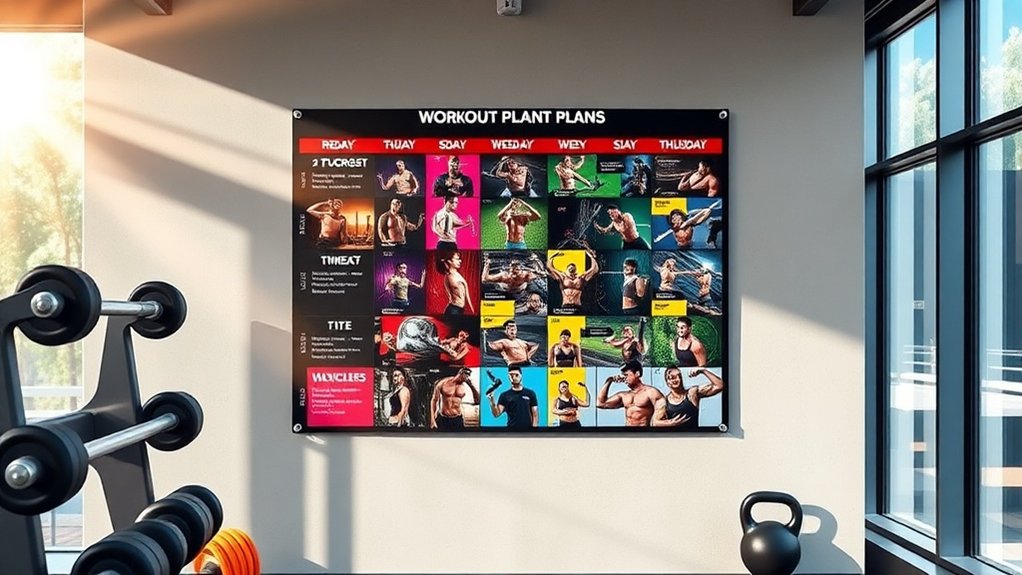A 5-day body part split allocates each training session to a specific muscle group—chest, back, legs, shoulders, and arms—enabling you to perform 12-20 sets per muscle with 6-7 days recovery between sessions. While this approach suits advanced lifters with 2+ years experience, research shows training muscles twice weekly produces 50% greater strength gains than once-weekly protocols. You’ll need to manage recovery carefully since tendons and joints require 48-72 hours between targeted sessions. The following sections break down ideal volume parameters, exercise selection strategies, and evidence-based variations to maximize your hypertrophy outcomes.
What Is a 5-Day Body Part Split and How Does It Work?

A 5-day body part split divides your weekly training into five distinct sessions, each targeting a specific muscle group—typically chest, back, legs, shoulders, and arms.
This structure enables you to maximize training volume per session while facilitating recovery between workouts. Advanced lifters often favor these targeted workouts for their focused approach to muscle development.
However, research suggests training each muscle group once weekly may limit muscle protein synthesis compared to higher-frequency protocols, potentially compromising muscle growth efficiency.
While this split reduces overuse injury risk through adequate rest periods, it’s not ideal for beginners seeking efficiency in training.
You’ll find that focused workouts benefit experienced lifters who’ve developed proper form and can handle substantial volume, but newer trainees typically respond better to increased training frequency.
Benefits and Limitations of 5-Day Split Workouts for Muscle Growth
While 5-day split workouts offer focused attention on individual muscle groups, their once-weekly training frequency considerably undermines hypertrophy potential compared to higher-frequency protocols.
Although these routines score 8.8 on hypertrophy assessments, you’ll experience excessive recovery time between sessions for each muscle group, limiting advanced muscle growth. Research demonstrates that training each muscle group 2-3 times per week through full-body or upper/lower splits produces 50% greater strength gains than once-weekly training.
The structure creates overlapping fatigue concerns, as joints and tendons don’t recover as quickly as muscles, increasing injury risk.
While 5-day split workouts allow concentrated effort on specific areas, they don’t provide the ideal volume needed for significant hypertrophy. You’ll achieve superior muscle growth through higher frequency training methods that maximize protein synthesis opportunities throughout the week.
Popular 5-Day Workout Split Variations and Templates

Several evidence-based 5-day split configurations exist, each offering distinct training frequencies and recovery protocols that directly impact hypertrophy outcomes.
The Upper-Lower-Push-Pull-Legs variation allows training each muscle group twice weekly, optimizing muscle growth through strategic volume distribution.
Alternatively, the Full-Body Workout Split achieves superior hypertrophy effectiveness (10.0 rating) by targeting muscles five times weekly with reduced volume per session.
The traditional 5-day Bro Split isolates individual muscle groups once weekly but risks accumulating junk volume.
Consider these comparative effectiveness markers:
- U/L/P/P/L hybrid: 9.0 hypertrophy rating with balanced time investment
- Upper/Lower split: Delivers 85% of maximum gains with 30% less time in the gym
- Full-body approach: Maximum frequency but requires precise volume management
Your selection should prioritize training frequency over excessive volume per session while accommodating your recovery capacity and schedule constraints.
Volume Guidelines and Exercise Selection for Each Muscle Group
Setting appropriate training volume represents the cornerstone of programming effectiveness, with research consistently demonstrating that 10-20 weekly sets per muscle group maximizes hypertrophy while maintaining recovery capacity.
Your exercise selection should prioritize compound exercises as foundational movements, supplemented with isolation exercises for targeted muscle group development.
Incorporate varied rep ranges—6-12 repetitions for hypertrophy and 1-5 for strength adaptations—to maximize ideal muscle growth outcomes.
Implement 48-72 hours recovery time between sessions targeting identical musculature to prevent overtraining syndrome.
Every movement you select must allow full range of motion execution while maintaining proper form throughout the entire kinetic chain.
This evidence-based approach to volume guidelines and exercise selection guarantees progressive overload while minimizing injury risk, creating sustainable adaptations for long-term muscular development.
Is a 5-Day Split Right for You? Who Should Use This Training Approach

Before committing to a 5-day split protocol, you must evaluate your training age, recovery capacity, and schedule availability to determine program compatibility.
Advanced lifters benefit most from this approach, as higher training volume and focused sessions on specific muscle groups optimize hypertrophy through increased training frequency. Research confirms that targeting muscle groups twice weekly improves muscle growth more effectively than once-weekly protocols.
This 5-day split suits you if:
- You’ve consistently trained for 2+ years and can safely execute compound movements with proper form
- Your schedule accommodates five weekly gym sessions with adequate recovery time between workouts
- You’ve plateaued on full-body workouts or 3-day splits and require progressive overload strategies
Beginners should prioritize full-body workouts initially to establish movement patterns and work capacity before advancing to specialized splits.
Frequently Asked Questions
What Is the 3-3-3 Rule in Gym?
The 3-3-3 Rule structures your strength training by performing three sets of three exercises targeting specific muscle groups, optimizing workout duration and exercise frequency. This approach improves muscle recovery while supporting fitness goals through consistent progress tracking and proper warm-up routines for injury prevention.
What Is the 4 8 12 Rule?
The 4-8-12 rule structures your workout intensity by performing four sets: one with four reps for strength progression, eight for power, and twelve for hypertrophy. You’ll optimize exercise variety while confirming proper muscle recovery between sets.
What Is the 5 4 3 2 1 Workout Method?
You’ll perform five sets, four sets, three sets, two sets, one set—progressively decreasing volume across exercises. This method balances workout intensity with exercise variety, boosting strength training and muscle endurance while allowing strategic recovery strategies between movements for peak fitness progression.
What Is the 3 2 1 Rule in Gym?
The 3-2-1 rule optimizes workout efficiency by combining three strength training sets, two hypertrophy sets, and one conditioning set. You’ll achieve fitness goals through exercise variation, improved muscle recovery, and routine optimization while maintaining proper training frequency and goal setting.



